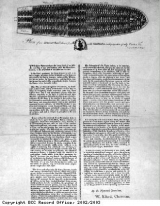The Atlantic crossing
The journey taken by the slave ships from Europe to Africa to the Americas is known as the ‘triangular trade’ , because of the three points of the route taken. After the initial part of the journey from Europe to Africa, the ship would arrive on the West African coast. The ship’s captain would trade for enslaved Africans. Once a slave ship had a full cargo of enslaved Africans, the captain would set out on the next leg of the journey. This leg, called the Middle Passage , took the Africans away from their homeland, across the Atlantic Ocean to the Americas. Once there they were sold and would work on the European-owned plantations.
Conditions on the Middle Passage were hard. The ship’s hull might hold 100 or 700 slaves. Most of the enslaved Africans did not live by the coast. They had never seen the sea before, let alone been on a ship. Many would suffer from seasickness. Men were chained together, to prevent rebellion. Chained, they would find it difficult to get to the buckets that served as toilets. Usually, all the slaves were taken up on deck for fresh air and exercise each day. The hull could be cleaned at that time. But in bad weather, the slaves had to remain in the hold, perhaps for weeks on end. The conditions they lived in can only be imagined.
For the modern day descendants of enslaved Africans, the image of the slave ship has today come to represent not only the horrors of the Middle Passage, but also the strength and resilience of those who survived it. As Cheryl Finley wrote on the slave-ship as an icon, ‘It is an image that repeatedly affirms our ability to rise to the surface from the depths of our past.’




